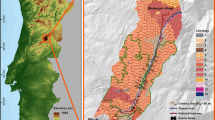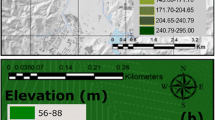Abstract
Commonly used post-fire debris flow statistical triggering models consider predictor variables that account for; rainfall intensity, rainfall accumulation, area burned, burned intensity, geology, slope, and others. These models represent the physical process of debris flow initiation and subsequent failure by quantifying near-surface soil characteristics. Shear wave velocity as a proxy for sediment shear stiffness informs the likelihood of particle dislocation, contractive or dilative volume changes, and downslope displacement that result from flow-type failures. This broadly available variable common to other hazard predictions, such as liquefaction analysis, provides good coverage in the watersheds of interest for debris flow predictions. A logistic regression is used to compare the new variable against currently used variables for predictive post-fire debris flow triggering models. We find that the new variable produces slightly improved performance in prediction of triggering while better capturing the physics of flow-type failure. Additional suggestions are presented for utilizing statistical cross-validation methods to advance prediction performance and the utility of different variables for quick assessment of likelihood during post-fire rainfall events.










Similar content being viewed by others
References
Addison P, Oommen T (2020) Post-fire debris flow modeling analyses: case study of the post-Thomas Fire event in California. Nat Hazards 100(1):329–343. https://doi.org/10.1007/s11069-019-03814-x
Akaike H (1974) A new look at the statistical model identification. IEEE Trans Automat Contr 19(6):716–723
Cannon SH, DeGraff J (2009) The increasing wildfire and post-fire debris-flow threat in western USA, and implications for consequences of climate change. In: Landslides–disaster risk reduction, pp 177–190, Springer
Cawley GC, Talbot NLC (2010) On over-fitting in model selection and subsequent selection bias in performance evaluation. J Mach Learn Res 11:2079–2107
De Graff JV (2018) A rationale for effective post-fire debris flow mitigation within forested terrain. Geoenvironmental Disasters 5(1):1–9
Dowling CA, Santi PM (2014) Debris flows and their toll on human life: a global analysis of debris-flow fatalities from 1950 to 2011. Nat Hazards 71(1):203–227
Gartner JE, Cannon SH, Santi PM (2014) Empirical models for predicting volumes of sediment deposited by debris flows and sediment-laden floods in the transverse ranges of southern California. Eng Geol 176:45–56. https://doi.org/10.1016/j.enggeo.2014.04.008
Heath DC, Wald DJ, Worden CB, Thompson EM, Smoczyk GM (2020) A global hybrid VS 30 map with a topographic slope–based default and regional map insets. Earthq Spectra 8755293020911137
Hungr O (2008) Simplified models of spreading flow of dry granular material. Can Geotech J 45(8):1156–1168
Iverson RM, Reid ME, LaHusen RG (1997) Debris-flow mobilization from landslides. Annu Rev Earth Planet Sci 25:85–138
Kayen R, Moss RES, Thompson EM, Seed RB, Cetin KO, Der Kiureghian A, Tanaka Y, Tokimatsu K (2013) Shear-wave velocity–based probabilistic and deterministic assessment of seismic soil liquefaction potential. J Geotech Geoenvironmental Eng 139(3):407–419
Kean JW, Staley DM, Lancaster JT, Rengers FK, Swanson BJ, Coe JA, Hernandez JL, Sigman AJ, Allstadt KE, Lindsay DN (2019) Inundation, flow dynamics, and damage in the 9 January 2018 Montecito debris-flow event, California, USA: opportunities and challenges for post-wildfire assessment. Geosphere 15(4):1140–1163. https://doi.org/10.1130/ges02048.1
Kean JW, Staley DM, Cannon SH (2011) In situ measurements of post‐fire debris flows in southern California: comparisons of the timing and magnitude of 24 debris‐flow events with rainfall and soil moisture conditions. J Geophys Res: Earth Surf 116(F4)
Kotok EI (1935) Kotok and Kraebel on flood and erosion problems. Trans Am Soc Civ Eng 1935:1350–1355
Lyman (2020). Incorporating shear resistance into debris flow triggering model statistics. Thesis in partial fulfilment of MS degree. California Polytechnic State University, San Luis Obispo. https://digitalcommons.calpoly.edu/theses/2254/
McGuire LA, Rengers FK, Kean JW, Staley DM, Mirus BB (2018) Incorporating spatially heterogeneous infiltration capacity into hydrologic models with applications for simulating post-wildfire debris flow initiation. Hydrol Process 32(9):1173–1187
McKenna JP, Santi PM, Amblard X, Negri J (2012) Effects of soil-engineering properties on the failure mode of shallow landslides. Landslides 9(2):215–228
Moss RES (2008) Quantifying measurement uncertainty of thirty-meter shear-wave velocity. Bull Seismol Soc Am 98(3):1399–1411
Moss RE, Seed RB, Kayen RE, Stewart JP, Der Kiureghian A, Cetin KO (2006) CPT-based probabilistic and deterministic assessment of in situ seismic soil liquefaction potential. J Geotech Geoenvironmental Eng 132(8):1032–1051
Moss RES (2019) Commonalities between debris flows and flow failures. In: Proceedings of the seventh international conference on debris-flow hazards mitigation, Golden, Colorado, USA, June 10–13, 2019, vol 1, Colorado School of Mines. Arthur Lakes Library
Murphy BP, Yocom LL, Belmont P (2018) Beyond the 1984 perspective: narrow focus on modern wildfire trends underestimates future risks to water security. Earth’s Future 6(11):1492–1497
Negri JA (2016) Evaluation and validation of multiple predictive models applied to post-wildfire debris-flow hazards. 2016—Mines Theses Diss., 1. https://doi.org/10.1017/CBO9781107415324.004
Renard KG (1997) Predicting soil erosion by water: a guide to conservation planning with the Revised Universal Soil Loss Equation (RUSLE). United States Government Printing
Rengers FK, McGuire LA, Kean JW, Staley DM, Hobley DEJ (2016) Model simulations of flood and debris flow timing in steep catchments after wildfire. Water Resour Res 52(8):6041–6061
Rengers FK, McGuire LA, Kean JW, Staley DM, Youberg AM (2019) Progress in simplifying hydrologic model parameterization for broad applications to post-wildfire flooding and debris-flow hazards. Earth Surf Proc Land 44(15):3078–3092
Rengers FK, McGuire LA, Oakley NS, Kean JW, Staley DM, Tang H (2020) Landslides after wildfire: initiation, magnitude, and mobility. Landslides (December 2019). https://doi.org/10.1007/s10346-020-01506-3
Rowe PB, Countryman CM, Storey HC (1949) Probable peak discharges and erosion rates from southern California watersheds as influenced by fire. US Dep. Agric. For. Serv. Calif. For. Range Exp. Station. 107 p
Rupert MG, Cannon SH, Gartner JE, Michael JA, Helsel DR (2008), Using logistic regression to predict the probability of debris flows in areas burned by wildfires, Southern California 2003–2006
Sakia RM (1992) The Box‐Cox transformation technique: a review. J R Stat Soc Ser D The Stat. 41(2):169–178
Schaefer JT (1990) The critical success index as an indicator of warning skill. Weather Forecast 5(4):570–575
Schmidt J, Moss R (2021) Bayesian hierarchical and measurement uncertainty model building for liquefaction triggering assessment. Comput Geotech 132:103963
Schwarz GE, Alexander RB (1995) State soil geographic (STATSGO) data base for the conterminous United States
Seed RB, Cetin KO, Moss RES, Kammerer AM, Wu J, Pestana JM, Riemer MF, Sancio RB, Bray JD, Kayen RE (2003) Recent advances in soil liquefaction engineering: a unified and consistent framework. In: Proceedings of the 26th annual ASCE Los Angeles geotechnical Spring seminar: Long Beach, CA
Staley DM, Negri JA, Kean JW, Laber JL, Tillery AC, Youberg AM (2017) Prediction of spatially explicit rainfall intensity–duration thresholds for post-fire debris-flow generation in the western United States. Geomorphology 278:149–162. https://doi.org/10.1016/j.geomorph.2016.10.019
Staley DM, Negri JA, Kean JW, Laber JL, Tillery AC, Youberg AM (2016) Updated logistic regression equations for the calculation of post-fire debris-flow likelihood in the western United States (2016–1106). https://doi.org/10.3133/ofr20161106
Staley DM, Kean JW, Rengers FK (2020) The recurrence interval of post-fire debris-flow generating rainfall in the southwestern United States. Geomorphology 370:107392
Tang H, McGuire LA, Rengers FK, Kean JW, Staley DM, Smith JB (2019) Developing and testing physically based triggering thresholds for runoff-generated debris flows. Geophys Res Lett 46(15):8830–8839
Thompson EMM (2018) An updated Vs30 map for California with geologic and topographic constraints: U.S. Geological Survey data release, US Geol. Surv. Data Release. 10, F7JQ108S, https://doi.org/10.5066/F7JQ108S
Tillery AC, Rengers FK (2019) Controls on debris-flow initiation on burned and unburned hillslopes during an exceptional rainstorm in southern New Mexico, USA, Earth Surf Process Landforms, n/a(n/a). https://doi.org/10.1002/esp.4761
Tillery AC, Rengers FK (2020) Controls on debris-flow initiation on burned and unburned hillslopes during an exceptional rainstorm in southern New Mexico, USA. Earth Surf Proc Land 45(4):1051–1066
USGS (2005) NOAA-USGS debris-flow warning system—final report, US Geol. Surv. Circ., 44
Wald DJ, Allen TI (2007) Topographic slope as a proxy for seismic site conditions and amplification. Bull Seismol Soc Am 97(5):1379–1395
Westerling AL, Hidalgo HG, Cayan DR, Swetnam TW (2006) Warming and earlier spring increase western US forest wildfire activity. Science (80-. )., 313(5789), 940–943
Yazdi JS, Moss RES (2017) Nonparametric liquefaction triggering and postliquefaction deformations. J Geotech Geoenviron Eng 143(3):4016105
Yong A (2016) Comparison of measured and proxy-based VS 30 values in California. Earthq Spectra 32(1):171–192
Yong A, Thompson EM, Wald DJ, Knudsen KL, Odum JK, Stephenson WJ, Haefner S (2016) Compilation of V S30 data for the United States, US Geological Survey
Acknowledgements
Integral to the success of this work was the generous support of the Warren J. Baker Endowment in Project-Based Learning and Robert D. Koob Endowment for Student Success. Additional resources were offered by the California Polytechnic State University – San Luis Obispo Graduate Assistantship Fund. We also want to thank research at the USGS, NOAA, and the California Geologic Survey for their data collection, and there works of debris flows. Finally, we would like to thank Dennis Staley, Jason Kean, and the many other collaborators for their work and models that this work builds upon.
Funding
Financial support came from the Warren J. Baker Endowment in Project-Based Learning and Robert D. Koob Endowment for Student Success at Cal Poly. Additional resources were offered by the California Polytechnic State University – San Luis Obispo Graduate Assistantship Fund.
Author information
Authors and Affiliations
Contributions
Both authors contributed to the completion of this research. Robb Moss conceived of the idea and developed the proof of concept, including initial statistical analysis and modeling. Noah Lyman performed data collection and thorough statistical analysis to fill out the study. Portions of this manuscript were taken from the MS Thesis of Noah Lyman, which was edited and commented on by Robb Moss. The manuscript as a whole was drafted by Robb Moss with edits, comments, and contributions by Noah Lyman. Both authors approve of the final manuscript.
Corresponding author
Ethics declarations
Conflict of interest
The authors have no relevant financial or non-financial interests to disclose.
Additional information
Publisher's Note
Springer Nature remains neutral with regard to jurisdictional claims in published maps and institutional affiliations.
Rights and permissions
About this article
Cite this article
Moss, R.E.S., Lyman, N. Incorporating shear stiffness into post-fire debris flow statistical triggering models. Nat Hazards 113, 913–932 (2022). https://doi.org/10.1007/s11069-022-05330-x
Received:
Accepted:
Published:
Issue Date:
DOI: https://doi.org/10.1007/s11069-022-05330-x




